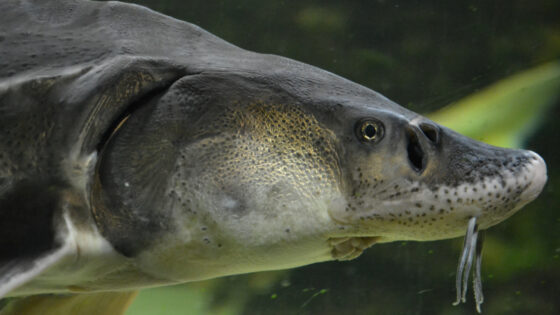Low Levels of Fracking Wastewater Highly Toxic to Mayflies
Stroud Water Research Center scientists find mayflies, whose presence indicates good water quality, are significantly affected by low levels of produced water.
By Diane Huskinson
An explosion of natural gas drilling in recent years is primarily the result of advances in horizontal drilling technology and the use of hydraulic fracturing (aka fracking) to release the natural gas from deep shale beds. Fracked wells can be found in the Marcellus shale in Pennsylvania as well in shale beds in Colorado, Wyoming, Arkansas, Texas, Ohio, and North Dakota.

The combination of horizontal drilling and fracking enables the recovery of formerly inaccessible natural gas (and crude oil). However, it has sparked much debate over the production of large volumes of potentially toxic wastewater that is currently stockpiled on site and later disposed of. Proper procedures for the treatment, reuse, and safe disposal of wastewater remain unsettled issues.
A question the Delaware River Basin Commission (DRBC) has asked is how the wastewater produced after a well has been fracked and is producing natural gas might affect aquatic animals if it reaches streams.
So this year, Stroud Water Research Center scientists conducted a study to evaluate how three mayfly species would respond to produced water from natural gas wells and compared them to the responses of fish and daphnid species, tiny freshwater crustaceans called water fleas. They submitted their final report to DRBC in August, and the results are now public.
What did they conclude? Produced water in concentrations near 1% will significantly affect mayflies in the short term (an exposure that lasts only 48 hours). In the long term (over the course of a 20-30 day mayfly lifecycle), it’s even lower: less than 0.25%.
Why Mayflies?
Mayflies have been a hallmark of the Stroud Center’s studies over the years — in large part because they are sensitive to changes in water chemistry, temperature, and other environmental variables.
Senior Research Scientist John Jackson, Ph.D., led the study. He said, “Mayflies are a very reliable indicator of whether a stream is healthy or not healthy. When it comes to streams, we want to see vibrant communities of mayfly species there. So their conspicuous absence in a stream tells us something isn’t right. It’s not an environment where they are thriving.”
The Method
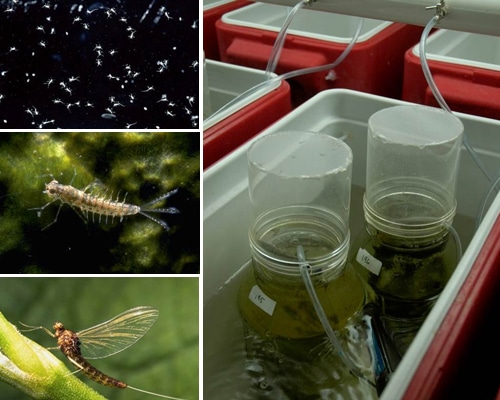
Jackson’s team, including David Funk and Michael Broomall, compared four measures of response across the three mayfly species when exposed to a range of produced water concentrations diluted in stream water: survivorship, development time, adult body size, and reproduction rate.
The stream waters came from two Exceptional Value streams: Dyberry Creek in the Pocono region of Pennsylvania and White Clay Creek, near Stroud headquarters in Chester County.
“Dyberry and White Clay are two very clean streams,” said Funk. “The mayfly species we tested can be found in both these streams, so we started with ideal conditions.”
Before testing how the mayflies responded to produced water, the team first looked at how the mayflies responded to what scientists call a reference toxicant: in this case, sodium chloride (NaCl), which is table salt. They exposed the mayflies to a variety of NaCl concentrations and found the lethal concentration for 50% of the population: the LC50. That gave them a reference point for what the range of produced water concentrations should be because NaCl can be a major component in produced water. The produced water sample examined in this study had a NaCl concentration that was more than four times greater than in seawater.
While mayflies are a valuable species for evaluating water quality, they are not widely used outside of Stroud Water Research Center. Collecting and rearing enough at the same life stages for lab studies is difficult. Therefore, standard lab tests for water quality instead look at how fish and daphnids respond to a particular toxicant. In the 1980s and 1990s, Center scientists developed a method of producing large numbers of mayflies for research studies.
In addition to comparing the response among three mayfly species (Centroptilum triangulifer, Procloeon rivulare, and Pseudocloeon frondale), the team also compared mayfly responses to those observed by a private testing firm using two species traditionally used in water toxicity testing: a daphnid species (Ceriodaphnia dubia or water flea) and a fish species (Pimephales promelas or fathead minnow). Comparing the different species helps scientists determine which organisms are most affected when exposed to produced water.
The Results
- Half the mayflies across all three species died after 20-30 day exposures to concentrations of less than 0.5% produced water.
- Among the mayflies that survived to reach the adult stage, development time slowed, indicating they were stressed.
- Reproduction rate was significantly reduced in two of three species and somewhat reduced in the third, mostly because mortality increased and development time slowed.
- The water flea was less sensitive than mayflies to produced water, but the fathead minnow was more sensitive than mayflies.
- The produced water was more toxic to mayflies in soft waters (Dyberry Creek) than in moderately hard waters (White Clay Creek).
“What this tells us,” said Jackson, “is that produced water is extremely toxic for mayflies even in concentrations as low as 1%. That’s significant. For example, in a small stream, it won’t take much produced water entering the stream for mayflies to die or otherwise show signs of stress, which together could result in measurable changes in stream invertebrates and fish.”
Our reputation for scientific rigor, intellectual integrity, and unbiased science has instilled public trust in our work and in our word. When we receive a grant to do important research, we do the work at the highest level possible, regardless of whether the funding will cover all the time necessary to complete the research. If our research is important to you, please consider making a gift to support it. Thank you!
Did You Know?
Most mayflies lay their eggs immediately after mating; the eggs then take anywhere from 10 days to many months to hatch. Cloeon cognatum is an exception.
This species (not used in the fracking study) is ovoviviparous, which means that a mated female holds her eggs internally until embryonic development is complete. After about 18 days she lays them in water and they hatch immediately. In this video by Center entomologist, David Funk, the mayfly begins to lay her eggs moments after she was dropped onto the water surface and the hatchlings begin to swim out of their eggs less than a minute later.
Stroud Celebrates Women Pioneers in Science
By Diane Huskinson
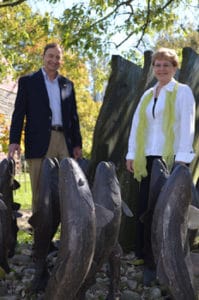
For Stroud Water Research Center, 2013 was a year of celebrating women pioneers in the field of science.
At our Water’s Edge gala on the evening of Oct. 15, 2013, the Stroud Center presented the Stroud Award for Freshwater Excellence to two remarkable women scientists: Jane Lubchenco, Ph.D., the first woman to serve as undersecretary of commerce for the National Oceans and Atmosphere Administration (NOAA), and Kathryn Sullivan, Ph.D., undersecretary of commerce for oceans and atmosphere and NOAA Administrator and the first woman to walk in space.
Their contributions to science and policy help make freshwater stewardship possible.
Explaining the significance of these two women’s leadership roles, Director Bern Sweeney said, “One of the largest and most important sources of environmental data in this country and in the world, for that matter, is the National Oceans and Atmosphere Administration, aka NOAA. We depend on NOAA on a minute-by-minute basis for a lot of the research we do.”
Earlier this year, Melinda Daniels, Ph.D., joined the Center’s elite team of senior scientists, walking in the footsteps of other pioneering women scientists, such as Ruth Patrick. Heading the new Fluvial Geomorphology Group, she quickly secured a lead PI position working under a grant from the National Science Foundation that is allowing her to investigate water sustainability in the U.S. Central Great Plains. Soon afterward, she was appointed by Secretary of Defense Chuck Hagel to serve on the Environmental Advisory Board of the U.S. Army Corps of Engineers.
Women scientists such as Lubchenco, Sullivan, and Daniels, are leading the charge to advance new knowledge and environmental stewardship, just as Ruth Patrick did during her eight-decade-long career studying streams.

Sadly, in September, Ruth Patrick, Ph.D., one of the world’s most notable and distinguished scientists who, along with Dick and Joan Stroud, founded Stroud Water Research Center, died at age 105.
Her passing made The Water’s Edge this year a bittersweet time for celebrating women pioneers in science.
“She was and always will be very special to us. Stroud Water Research Center carries on its work as part of her legacy,” Director Bern Sweeney said later.
Brilliant, immensely amiable, and tireless, she was an unstoppable force: she turned research into action by networking with movers and shakers such as industry CEOs and political leaders. She understood early in her career, just as Lubchenco, Sullivan, and Daniels do today, the importance of relationships and communication in making large-scale improvements to enable freshwater stewardship.
Upon accepting her award, Lubchenco echoed Patrick’s belief in effective communication: “Science is critical, but it’s not sufficient. Clear communication of scientific results is really important and so too are relationships, funders, diplomacy, and changing incentives. With the right combination of people and events, we can achieve sustainable solutions. I think, collectively, until we solve the problems that are going on in D.C., much of the action is going to be at the local and state levels.”
Center Director Bern Sweeney, Ph.D., and Board Chairman Rod Moorhead presented the award to Lubchenco, who also accepted on behalf of Sullivan. Sullivan was unable to attend due to the federal government shutdown.
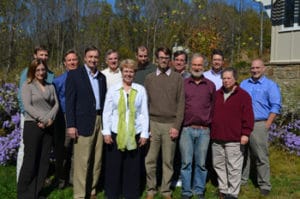
Under Lubchenco’s leadership, NOAA has focused on restoring fisheries to sustainability and profitability, restoring oceans and coasts to a healthy state, ensuring continuity of the nation’s weather and other environmental satellites, developing a Weather-Ready Nation, promoting climate science and delivering quality climate products, strengthening science and ensuring scientific integrity at NOAA, and delivering the highest quality science, services, and stewardship possible.
Sullivan has traversed the frontiers of space and sea. An accomplished oceanographer, she was appointed NOAA’s chief scientist in 1993, where she oversaw a research and technology portfolio that included fisheries biology, climate change, satellite instrumentation, and marine biodiversity. She was one of the first six women selected to join the NASA astronaut corps and the first American woman to walk in space.
The Stroud Award for Freshwater Excellence, also known as the SAFE Water Award, is awarded for outstanding achievement to those who contribute broadly to the conservation and protection of fresh water. A unique crystal vase designed by Simon Pearce accompanies the award. Past recipients have included John Briscoe, Ph.D., in 2012, and Olivia Newton-John and John Easterling in 2011.
Staff Spotlight: Information Services
By Diane Huskinson
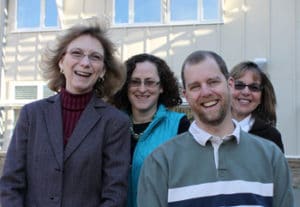
Say hello to Charlie Dow, Heather Brooks, Libby Gregg, and Melanie Arnold. They are the cool people whose sharp skills keep Stroud Water Research Center’s information systems running. Our science relies on computing technology, and we rely on the Information Services team to ensure our computer systems work as needed, our data are processed from number soup to useful stats, and our electronic communications flow efficiently and effectively.
Web developer Heather Brooks joined the staff in 1988 as a staff scientist in the Microbiology Group. While her bachelor’s degree in entomology comes in handy when communicating about complicated science on the Center’s websites and social media channels, she’s never worked in the Entomology Group. Instead, she moved from lab work to data analysis to Web development. It was Brooks herself who suggested and then created her current position as the Center’s first in-house Web developer.
Dow explains, “Heather took the initiative. She started taking classes and learning more about Web design and maintenance. Her knowledge and creativity make her an invaluable part of our team.”
The digital world keeps changing, and in turn, Brooks continues to seek out new knowledge, growing her already impressive skill set.
Gregg comments, “This is the kind of place where you can do that. The environment here allows people to grow — to find new ways of serving the Center’s mission while using their talents. Heather is a great example of that.”
When Libby Gregg came on board 12 years ago, she worked part-time while she earned her bachelor’s degree in agriculture and a minor in wildlife conservation. As the systems administrator, she manages the Center’s information technology needs, overseeing all aspects of our computing network. She’s also an educator who teaches the Stream Study program to student groups visiting the Center.
As resourceful as she is reliable, she’s in high demand among the staff: “In some ways,” says Dow, “Libby has the toughest job because IT is mostly solving problems, but she troubleshoots well. Even better — she knows what she knows, and she knows what she doesn’t know. She’s not afraid to say, ‘I don’t know, but I’ll find the answer.’”
As a data analyst, Melanie Arnold interacts not just with folks in the research groups but also with our education and accounting groups. One of her many strengths is her ability to solve data management issues regardless of where the data originate. She holds a bachelor’s in natural resources and environmental science and a master’s in environmental science. She joined the staff in 2004.
“One of the things that’s great about Melanie is that it’s so easy to work with her,” Dow says. “She’s easy-going and accommodating. She does her job really well.”
“Charlie’s easy to work with, too,” Brooks says, “I guess we all feel that way about each other. But his management style fits us to a T.” That’s because Dow encourages his team to work independently with the other groups at the Center, with minimal input from him.
He admits, “My style is very hands-off, and I’m very fortunate to work with people who are self-motivated and reliable.”
“At the same time,” says Gregg, “Charlie is there for us to run interference and prioritize requests so that we aren’t overwhelmed by too many things at once.”
Dow earned his B.S. in chemistry, his M.S. in the Environmental Pollution Control program at Penn State, and his Ph.D. in forest resources with a minor in statistics, also from Penn State. As it turned out, that minor in statistics significantly shaped Dow’s career path. As director of information services, his primary duties include managing and analyzing all manner of data produced by the Center’s research and education groups; this includes being responsible for the Center’s geographic information systems.
Dow expresses praise for his team and says, “Each of them fills an important role that no one else in the group could fill, so we really rely on each other’s strengths. That and the fact that we get along so well makes us an effective team.”
News and Presentations
Moorhead Environmental Complex Featured as Greenbuild Destination; Receives Awards, Media Attention
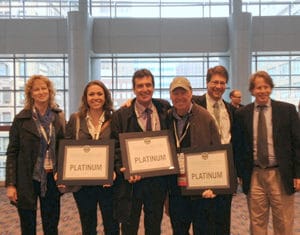
Photo: Holley Henderson
The Moorhead Environmental Complex, LEED® certified to the Platinum level, was highlighted at the Greenbuild International Conference and Expo held in Philadelphia on November 20-23. The traveling venue hosts nearly 30,000 attendees each year.
An hour-long presentation on the Moorhead Environmental Complex was given on Friday morning to more than 150 attendees by members of the design team, lead Architect Muscoe Martin (M2 Architecture), landscape architect José Almiñana (Andropogon), Molly Jullian (Meliora Environmental Design), and Dave Arscott, Ph.D., the Center’s assistant director. Arscott recognized the design and build teams’ efforts with framed LEED Platinum certificates at the end of the presentation.
On Saturday morning, a tour bus group of more than 40 people visited the Center for a facilities tour, during which they learned about the Center’s approach to “Getting the Water Right.” Arscott and Amy Cornelius of the Delaware Valley Green Building Council (also LEED AP with GreenBeams, LLC) guided the group to the Center’s headquarters in Avondale.
Martin, Michele Adams (Meliora Design), and Steve Green (Nason Construction) shared information about the various sustainable technologies associated with the new building. The tour group concluded their all-day field trip with a behind-the-scenes tour of the Longwood Gardens living wall and their innovative water conservation, recycling, and treatment systems.
In advance of the Greenbuild Expo, the Moorhead Environmental Complex was recognized by the magazine Green Building and Design in their November/December issue for the building’s innovative green solutions.
The Moorhead Environmental Complex was also recently recognized by the Temple Villanova Sustainable Stormwater Initiative (TVSSI) on October 16 at Villanova University with an award for one of the best new stormwater control measure projects: Getting the Water Right at Stroud Water Research Center. Adams and Arscott were on hand to receive the award.
Stroud Presents Freshwater Threats and Stream Restoration Practices
With the launch of the Watershed Restoration Group in January, Stroud Water Research Center has been busy sharing what science tells us about threats to streams and how we can restore them.
On November 5 and 7, Director Bern Sweeney, Director of Watershed Restoration Matt Ehrhart, Watershed Restoration Manager Dave Wise, and Lamonte Garber of the Chesapeake Bay Foundation presented a field and laboratory workshop covering the technical details of why and how to create forest buffers along streams to improve water quality. Topics included implementation, federal and state cost-sharing programs, and maintenance. The workshop was co-sponsored by the Center, the Chesapeake Bay Foundation, and Pa. DCNR Bureau of Forestry.
Sweeney and Ehrhart also gave a presentation on November 18 about cutting-edge technologies for choosing streams to restore, implementing the restoration, and measuring restoration success. The presentation was sponsored by the Mellon Foundation.
On October 8, at the Susquehanna River Science Forum in Harrisburg, Pa., Sweeney moderated a discussion of a variety of challenges and threats to the integrity of the Susquehanna River. It was sponsored by the Susquehanna River Basin Commission.
Mosher Talks Metaecosystems at AGU Meeting
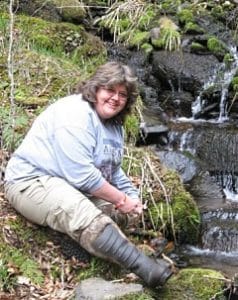
On December 13, Post-Doctoral Associate Jen Mosher gave an oral presentation at the Fall Meeting of the American Geophysical Union in San Francisco for the session “Linking Microbial Communities and Biogeochemistry to Ecosystem Processes and Environmental Change.”
Based on the Metaecosystems project, which was funded by the National Science Foundation, the presentation described important shifts along a downstream gradient in three distant watersheds. Shifts were noted in sediment and rock biofilm bacterial communities — as well as in the composition of dissolved organic matter in stream water.
In the original paper written by Mosher, Center scientists Lou Kaplan and Jinjun Kan and others, the authors also explain the correlation between the bacterial community structure and DOM molecular composition in these streams.
Kan Heads to China to Share Molecular Microbial Ecology and Ecophysiology Findings
On October 22, Assistant Research Scientist Jinjun Kan gave a talk in China at Tianjin University of Science and Technology, where last year he was granted a visiting professorship.
Kan’s work in microbial ecology has helped improve our understanding of microorganisms both in their natural ecosystems and in engineered environmental settings.
In his talk, he explained how studying microorganism communities and populations in microbial fuel cells as well as in Yellowstone Lake and the Chesapeake Bay led to the discovery that spatio-temporal distribution patterns of microbes are closely related to their environments. This suggests the microbes are able to adapt to their environment.
Medved Shares Value of Leaf Pack
Slimy leaves and clean streams go hand in hand. Education Programs Manager Christina Medved gave a presentation on the Leaf Pack Experiment, which uses leaf litter to assess water quality, to about 70 attendees at the 11th Annual Lancaster/Lebanon County Watershed Forum on October 26. The event was held at Acorn Farms Reception & Conference Center in Mount Joy, Pa.
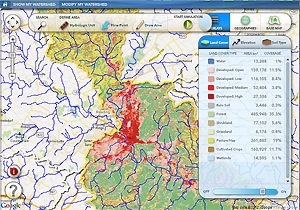
Gill Presents Model My Watershed® to Environmental Educators
On October 12, Director of Education Susan Gill, along with Nanette Marcum-Dietrich of Millersville University, gave a presentation of Model My Watershed® at the 42nd Annual North American Association for Environmental Education Conference in Baltimore.
An interactive Web tool, Model My Watershed® enables students to learn about their watershed and the impacts of land use on water quality and the environment.

